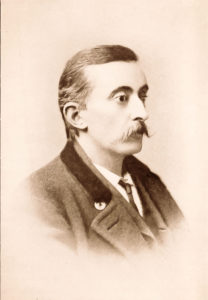
© Koizumi Family
The Greek-Irish writer Lafcadio Hearn (Koizumi Yakumo, 1850-1904) was born in Greece. He lived in Ireland, the United Kingdom, France, the USA and on the Caribbean island of Martinique, before arriving in Japan in 1890. He is known as a writer who communicated the fundamental culture of Japan in the Meiji era to the world through acute insights with his five senses.
Exactly 150 years ago, in 1869, Hearn, aged 19, arrived in New York alone, as an Irish immigrant. Throughout his childhood, he had overcome much hardship. After his arrival in the USA, he worked as a journalist, and as a folklorist, in Cincinnati and New Orleans. He continued such work for around 20 years, and established himself as a top class journalist and writer. During this time, he worked for four newspapers. His interest in folklore led to his dedicated exploration of non-Christian religious culture, which at that time, did not attract much scholarly interest. He also translated French literature, retold supernatural stories from around the world, and explored Creole culture. He wrote travelogues and novels based on his experiences in Louisiana and the West Indies island of Martinique. From an intellectual and methodological perspective, this became the solid foundation upon which he was able to build his understanding of Japan.
The World Exposition, which was held in New Orleans from 1884-1885, played a large role in developing Hearn’s fascination with Japan. He visited the Expo as a journalist, and was drawn strongly to the country after seeing the Japanese exhibits. Subsequently, he read the English translation of Kojiki (1882) in New York, and developed a deep interest in Japan, and the Izumo region in particular. The theme of this project is Hearn’s open mind, which respects diversity. This was cultivated in the blend of cultures he found in the USA. It was not long before his gaze turned to the fundamental culture of Japan, and he produced a large number of related works. Many of his works, of which Kwaidan is representative, explore the lives and spirituality of the ordinary people of Japan with respect. Today, they are still read widely around the world.
Lafcadio Hearn
Patrick Lafcadio Hearn was born to an Irish father, Charles, and a Greek mother, Rosa, in 1850 in Lefkada, Greece. He was educated in Ireland, the UK and France, before emigrating to the USA in 1869. He worked as a journalist in Cincinnati, New Orleans, and on the Caribbean island of Martinique. He communicated the fundamental cultures of those regions to the world through newspaper articles and books, which he wrote from a folklorist’s perspective. He became interested in Japanese culture through a visit to the Japanese pavilion at the New Orleans World’s Fair and the discovery of a book of Japanese mythology. He moved to Japan at the age of 39. He worked as an English teacher in Matsue and Kumamoto, a journalist in Kobe, and a university lecturer in Tokyo. He explored the spiritual culture of the Japanese people with an open mind, and introduced this to the world through more than ten works, including Glimpses of Unfamiliar Japan, Kokoro, Kwaidan, and Japan: An Attempt at Interpretation. In 1896, he married into the family of Setsu Koizumi. He became a naturalised Japanese citizen and took the name Koizumi Yakumo. He and Setsu had four children. He died of a heart attack in 1904.